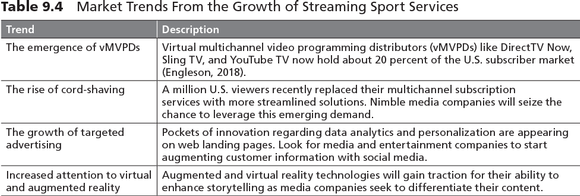Digital and emerging media in sports
This is an excerpt from Governance in Sport With Web Resource by Bonnie Tiell,Kerri Cebula.
By Galen Clavio and Matthew Zimmerman
Sport media operate as a subset of the broader news and entertainment media, and that has been true in both traditional media and in digital and emerging media. As social networks emerged in the early part of the 21st century, sports played varying roles in the development of content and consumers. In some cases, sport media developed their own niches, and occasionally sport media acted as a leading audience attraction on certain media platforms.
The sport media industry is similar to other media sectors that are evolving from a physical domain to a digital economy, where consumers often create and publish their own content. This self-publishing landscape is filled with major challenges for governance issues related to illegal file sharing, piracy, and copyright infringement, whether intentional or accidental.
According to a Bloomberg report, there are over 20 million requests a week on Google web search engines to remove web links to copyright-protected material (Mola & Ovide, 2016). In 2016, a central repository noted complaints of copyright infringement applicable to over 1.5 billion websites (Mola & Ovide, 2016). According to the 1998 Digital Millennium Copyright Act, companies are required to remove copyrighted material belonging to the rightful owner. When receiving notices of copyright violations, large Internet companies such as Facebook and YouTube often proceed to remove content without seeking permission from the person who published the material.
Due to the newness of digital and emerging media, traditional governance structures such as those found in broadcast and print ownership rules enforced by governments have not yet developed. Instead, the governance of these new media environments has been dictated by industry trends, audience affinities, and the suitability of certain technologies.
Net Neutrality
Complicating the sport media landscape even further has been the advent of high-speed Internet and mobile connectivity, the accompanying growth of social media, and online consumption of news and entertainment. While the World Wide Web was introduced in 1992, the importance of online sport media was minimal at best for the first 15 or so years following that date. Internet connections were slow, desktop-bound, and lacking infrastructure, since nearly all major aspects of sport media were still focused on traditional media channels such as printed newspapers, magazines, radio, and television.
However, the widespread growth of high-speed Internet in the early 2000s improved the quality and variety of available media content that consumers could access digitally. Instead of dial-up modem speeds restricting stories to words and an occasional photograph, high-speed Internet allowed for the transmission of data-rich media content such as audio and video.
By the end of the first decade of the 2000s, mobile devices had further enhanced the attractiveness of online sport media. The introduction of the iPhone in 2007 (Silver, 2018) created a new world for sport media, one where pictures, sounds, and videos were not only digitally accessible, but portable. As sales of the iPhone and its competitor phones spiked over the next decade, digital sport media in all forms became increasingly important to consumers and media companies alike. Organizations asserted regulations such as blogging policies and social network guidelines to monitor the online behavior of employees (Linke & Zerfass, 2013).
During the 2010s, a policy debate developed concerning the way in which Internet service providers and cellular phone companies should be required to handle the transmission of data. The net neutrality conversation has confused a great many people, often because of deliberate misinformation spread by parties to the debate.
In simple terms, the concept of net neutrality is that all data should be treated equally on the Internet by Internet service providers (ISPs) and that companies should not be allowed to favor certain types of content, or content from certain providers, over content provided by others. Supporters of net neutrality argue that this equality of content has been a building block of the success of digital media over its first few decades of development, with consumers able to access data across platforms and content providers with ease. Internet service providers and major content providers, however, have argued that net neutrality stifles innovation and consumer choice (Geller, 2015).
Net neutrality affects sport media in important ways. Access to any digital sport media content is made through an ISP, either via a high-speed Internet subscription or through a mobile phone data plan. The absence of net neutrality creates the possibility that one of these data providers could choose to block or restrict access to another company's content because it rivals the content being provided by that data company or its business partners. Hypothetically, the lack of net neutrality protections could allow a company like Verizon as a mobile data provider to partner with the NFL and allow privileged status to streaming video from that entity, while throttling or restricting access by consumers to streaming video from other professional leagues.
The FCC's position on net neutrality became a highly partisan issue during the last half of the 2010s, with a Barack Obama administration-appointed FCC chairman designating the Internet as a public telecommunications service under Title II of the Communications Act of 1934 (Ruiz, 2015). Two years later, a Donald Trump administration-appointed FCC chairman moved to roll back those protections, with the repeal of those rules taking effect in 2018.
It is uncertain what the future holds for net neutrality, but it is worth noting that sport media entities continue to expand into the digital media space, with large organizations such as ESPN launching subscription streaming services containing access to wide swaths of content (Ha, 2019). As streaming services continue to expand, particular media and entertainment trends have become apparent. These market trends are described in table 9.4.



Get the latest insights with regular newsletters, plus periodic product information and special insider offers.
JOIN NOW


